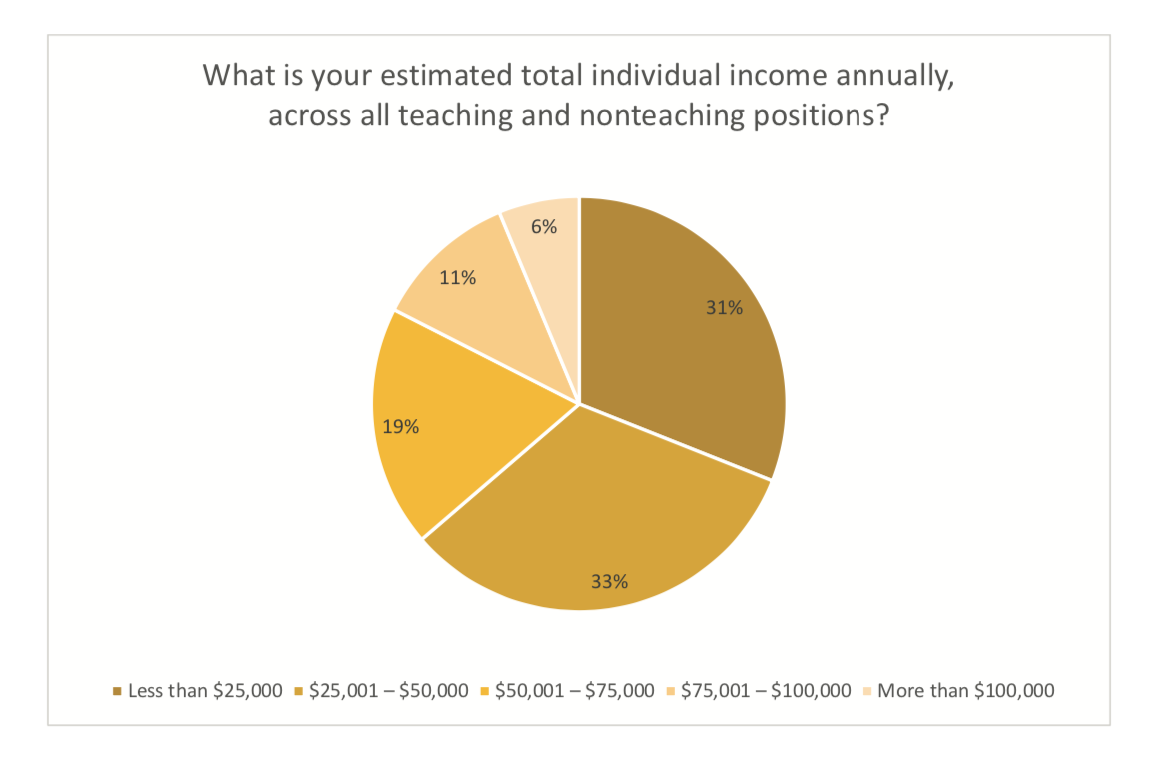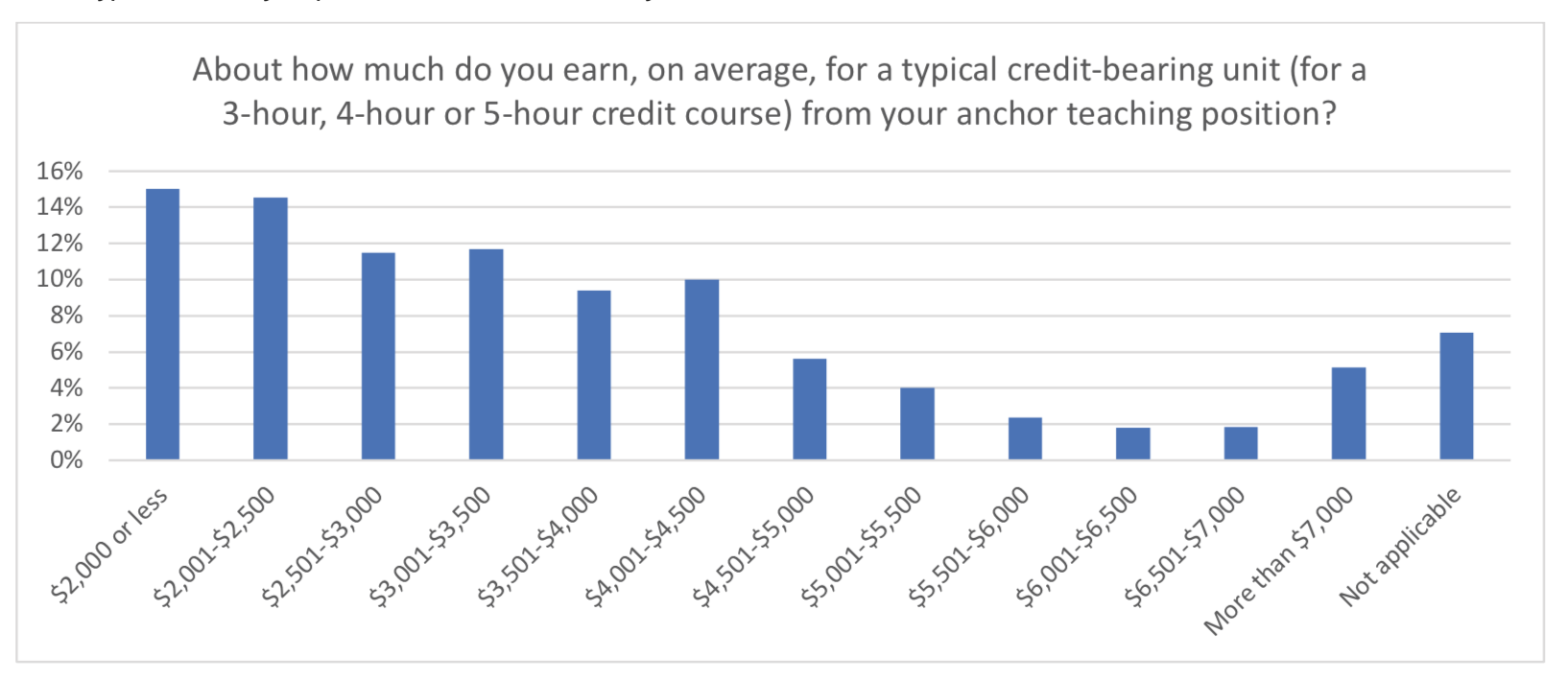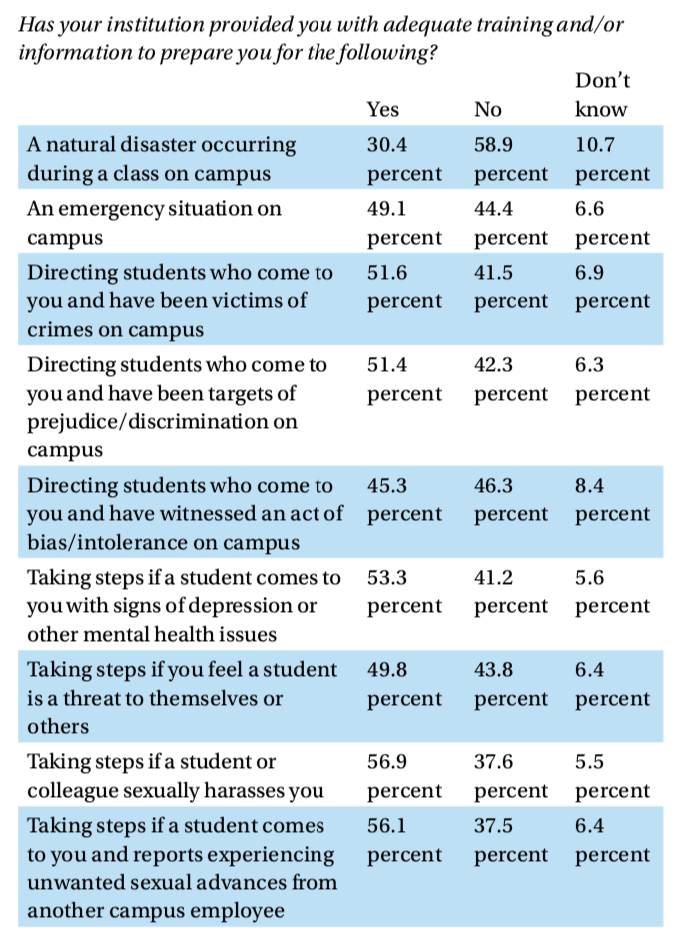Nearly 25 percent of adjunct faculty members rely on public assistance, and 40 percent struggle to cover basic household expenses, according to a new report from the American Federation of Teachers.
Nearly a third of the 3,000 adjuncts surveyed for the report earn less than $25,000 a year. That puts them below the federal poverty guideline for a family of four. Another third of respondents make less than $50,000.
Per-course pay varies from less than $2,000 to more than $7,000. About 53 percent of respondents make less than $3,500 per course. Asked about equitable compensation, more than half said they should be paid at least $5,000 per course.
‘An Army of Temps’
“An increase in the per-course minimum to this range would immediately benefit the vast majority of contingent faculty today,” states the report, "An Army of Temps," released today.

“Students are not receiving the best possible education when the instructor in front of them is struggling to decide whether to buy food or medicine, and students’ futures are jeopardized when an inspiring professor who could provide a recommendation or further mentorship is let go as soon as the academic term ends,” the report continues. “To secure the economic and social prosperity and justice that our members, our students and our nation deserve, we must address the problems afflicting higher education.”
That means “immediately seeking to restore and enhance funding for high-quality, affordable, accessible higher education, and reducing institutions’ reliance on contingent faculty premised on poverty wages and exploitation,” the report says. “If we want everything -- these institutions and the democracy they serve -- to go downhill faster, we can instead continue to ignore this perilous state of affairs.”
The survey period ended last June. But with colleges and universities across the country implementing hiring freezes and budget cuts due to the financial upheaval caused the coronavirus pandemic, and the potential for future fluctuations in enrollments, adjuncts' lives are now even more precarious.
Research on adjuncts is hard to pull off, as institutions aren’t always organized or forthcoming with their data on adjunct pay and other details. Adjuncts themselves may be difficult to track down because they often work on multiple campuses to string together something resembling a living. The most comprehensive survey of adjuncts was published in 2012, by the Coalition on the Academic Workforce. That survey found the median per-course pay was about $2,700, or $24,000 per year as a full-time-equivalent employee.
The Service Employees International Union, TIAA and the House Education and the Workforce Committee in the U.S. Congress, among other groups, have also published surveys on adjuncts since then. The AFT contends that its new report is the most thorough to date.
Randi Weingarten, AFT president, said through a spokesperson that the “impact of unstable and contingent work on students is tremendously understudied.”
Students and families take on “severe financial risks when they go to college,” she said, “and it's not well understood outside of academia just how little of that money is going to instruction.”
Many adjuncts are among the most experienced teachers on their campuses. But they often lack institutional support and training, which can negatively impact campus safety. Forty-four percent of instructors said they hadn’t been trained on what to do in the event of a campus emergency, for example. The same share said they had insufficient preparation for dealing with students posing a threat to themselves or others.
Over all, Weingarten said, the survey paints a “vivid portrait of how precarious labor provided by millions of adjunct faculty anchors their institutions' instructional work.”
Weingarten linked adjunct working conditions to growing unionization efforts. She said the AFT continues to fight for additional public funding for higher ed.
Prior to the pandemic, it would have taken $15 billion in additional federal and state investments in higher education over two years to get back to pre-2008 levels of public funding. Now, the “financial holes to be filled -- both in public investment and in the lives of individual adjunct and contingent faculty -- will be even bigger, and more perilous,” the report states.
A ‘Nightmare’
There’s a myth about adjuncts that just won’t die: that most have well-paying day jobs and teach as a hobby. Other studies have tried to disprove that misconception with facts, but the AFT’s data are especially sobering. Just 15 percent of adjuncts said they are able to comfortably cover basic expenses from month to month.
Caprice Lawless, an adjunct instructor of English at Front Range Community College in Colorado and chair of the American Association of University Professors’ Committee on Contingency and the Profession, said the AFT’s report “accurately describes the nightmare that more than a million teachers face in our country, trying to live on $25,000 a year. You can’t do it -- it can’t be done.”

Fewer than half of respondents have access to employer-provided health care. About 20 percent rely on Medicaid. Some 45 percent of faculty members have put off needed health care, including seeking help for mental health. Two-thirds have foregone dental care in the last 12 months due to the cost.
Just 54 percent of respondents have access to some paid sick leave, while just 17 percent have paid family leave and 14 percent have paid parental leave.
Lawless said she’s had to teach while sick with shingles and on the days of her parents’ respective deaths. Adjuncts at her college now have some sick leave after campaigning for it, she said.
Colleges and universities are increasingly granting adjuncts' requests for yearlong or multiyear contracts, but 41 percent of adjuncts still said they struggle with job security and don’t know if they’ll have a teaching job until one month prior to the start of the academic year. Three-quarters of professors said they only get semester-to-semester or quarter-to-quarter contracts.
As for retirement, some 37 percent of adjuncts said they can’t imagine how they’ll manage. Sixty-three percent are 50 or older. Nearly 40 percent of adjuncts have been teaching for 15 years or more, including as graduate employees.
The AFT’s report uses “adjuncts” to refer to part-time and full-time professors working off the tenure track. Nationally, about 20 percent of the faculty are full-time, non-tenure-eligible, compared to 12 percent of the AFT sample. Seventy-nine percent of respondents were part-timers, and 3 percent each were graduate employees, professional staff or other.
All professors surveyed teach at two- and four-year institutions. Nearly half the sample (46 percent) teach at four-year public institutions. Nine percent teach at four-year private colleges. About 4 percent teach at four-year for-profit institutions. Sixty-one percent of the sample teach at two-year publics. (The numbers don’t add up to 100 percent because many adjuncts teach on multiple campuses. Very small shares of respondents teach at two-year private or private for-profit campuses.)
About three-quarters of respondents are white. Four percent are black, 6 percent are Latinx, 3 percent are Asian or Pacific Islander. Three percent are multiracial, and the rest preferred not to answer. It is well established that underrepresented minorities and women are overrepresented among adjuncts. The AFT sample is 64 percent female, 33 percent male, 1 percent gender nonconforming and 0.1 percent transgender. Three percent didn’t answer.
The Contingent Faculty Movement
Adrianna Kezar, Wilbur Kieffer Endowed Professor and Dean's Professor of Leadership and director of the Pullias Center and of the Delphi Project on the Changing Faculty and Student Success at the University of Southern California, said the AFT’s data on salary, health-care access, job security, notification of courses and retirement parallel other previous findings.
Meanwhile, the AFT survey had “some really interesting new information around the areas of public assistance, training about student needs and food insecurity,” Kezar said. She also called the report “very timely,” given the financial choices institutions are facing this spring in the wake of the pandemic. 
Maria Maisto, president of the New Faculty Majority, a national adjunct advocacy organization, said adjuncts don’t face a dearth of information about their working conditions, so much as a “dearth of concern” about how those conditions affect all the faculty as a whole, students and the “integrity of higher education.”
Even more important than new data, she said, is that the “contingent faculty movement ally itself much more closely with all of the other precarious workers and gig economy activists who are working on broad, deep structural change. Solidarity is now more important than ever, on so many levels.” (Kezar's most recent book was about the gig academy.)
Maisto advised contingent professors to apply for unemployment insurance at the end of the semester -- and urged institutions not to stand in their way. Many colleges and universities obstruct access to unemployment benefits in typical years by “disingenuously asserting” that adjuncts have "reasonable assurance" of continued employment, she said. But contingent faculty members have never had “authentic” reasonable assurance of continued employment, “and that is even more obviously the case now.”
Lawless said she’d recently spoken to administrators within the Colorado Community College system and asked them to allow adjuncts to access state unemployment benefits, which in turn grant them access to expanded federal unemployment benefits. Another key request was fast-tracking an accelerated online teaching training and certification course for adjuncts to take over the summer.
The present crisis offers an opportunity to pause and imagine a better way forward, as the adjunct status quo is not sustainable, Lawless said.
“We’re the higher education equivalent of nurses working without masks.”
"Many" - Google News
April 20, 2020 at 02:08PM
https://ift.tt/2VJ1vFO
New report says many adjuncts make less than $3,500 per course and $25,000 per year - Inside Higher Ed
"Many" - Google News
https://ift.tt/2QsfYVa
Shoes Man Tutorial
Pos News Update
Meme Update
Korean Entertainment News
Japan News Update
Bagikan Berita Ini














0 Response to "New report says many adjuncts make less than $3,500 per course and $25,000 per year - Inside Higher Ed"
Post a Comment